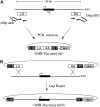Captured segment exchange: a strategy for custom engineering large genomic regions in Drosophila melanogaster
- PMID: 23150604
- PMCID: PMC3567733
- DOI: 10.1534/genetics.112.145748
Captured segment exchange: a strategy for custom engineering large genomic regions in Drosophila melanogaster
Abstract
Site-specific recombinases (SSRs) are valuable tools for manipulating genomes. In Drosophila, thousands of transgenic insertions carrying SSR recognition sites have been distributed throughout the genome by several large-scale projects. Here we describe a method with the potential to use these insertions to make custom alterations to the Drosophila genome in vivo. Specifically, by employing recombineering techniques and a dual recombinase-mediated cassette exchange strategy based on the phiC31 integrase and FLP recombinase, we show that a large genomic segment that lies between two SSR recognition-site insertions can be "captured" as a target cassette and exchanged for a sequence that was engineered in bacterial cells. We demonstrate this approach by targeting a 50-kb segment spanning the tsh gene, replacing the existing segment with corresponding recombineered sequences through simple and efficient manipulations. Given the high density of SSR recognition-site insertions in Drosophila, our method affords a straightforward and highly efficient approach to explore gene function in situ for a substantial portion of the Drosophila genome.
Figures






Comment in
-
Targeted gene replacement in Drosophila goes the distance.Genetics. 2013 Feb;193(2):377-81. doi: 10.1534/genetics.112.148379. Genetics. 2013. PMID: 23396476 Free PMC article. No abstract available.
References
-
- Baer A., Bode J., 2001. Coping with kinetic and thermodynamic barriers: RMCE, an efficient strategy for the targeted integration of transgenes. Curr. Opin. Biotechnol. 12: 473–480 - PubMed
Publication types
MeSH terms
Substances
Grants and funding
LinkOut - more resources
Full Text Sources
Molecular Biology Databases

